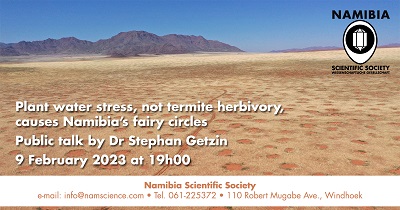
Scientific Society public talk to demystify the fairy circles

The Namibia Scientific Society will be hosting a public talk by Dr. Stephan Getzin, titled: “Plant water stress, no termite herbivory, causes Namibia’s fairy circles”, on 9 February at 19:00.
The fairy circles of Namibia have been called one of nature’s greatest mysteries and these circular grassland gaps form along the Namib below 150 mm mean annual precipitation, where moisture is overall too low to sustain a continuous layer with uniform vegetation.
The Namibia Scientific Society said Dr. Getzin studied the fairy icicles for the first time in the Kaokoveld in the year 200 when the resulting publication established the term ‘fairy circles’ in the scientific literature and since then he has closely followed research developments on the subject.
“In 2012, he began a detailed analysis of the spatial patterns of the fairy circles and thereby tested the plausibility of various hypotheses about the origin of the circles. Since he visited the Namib Desert every year, covering all the hotspot regions where fairy circles occur,” they added.
The Society further explained that he visited the fairy circles, especially during the rainy seasons of 2020 and 2022, in several regions of Namib immediately after the rains.
“In his talk, he will give an overview of his past research on testing the ‘abiotic gas’, the Euphorbia, or the social insect hypotheses and he will present the major findings of his recent fieldwork, which was just published in October 2022,” they emphasised.
They highlighted that in his presentation, Dr. Getzin will not only show that the Stipagrostis grasses form fairy circles via plant self-organization and he will also show so far unknown plant rings of the Namib, where annual Schmidtia grasses and annual Limeum forbs engineer similar but smaller circles, to exclusively utilize the soil water from the interior of these rings.
DR. Getzin is from the University of Gottingen in Germany and is an associate member of the Gobabeb Namib Research Institute
He was the first full-time student from Germany at the University of Namibia in Windhoek, where he studied biology and geography. In his B.Sc. The thesis he specialized in is grass species diversity and grazing dynamics in the Khomas Hochland.
He wrote his M.Sc. Thesis at the University of Potsdam in Germany about, Structural Fire Effects in the World’s Savannas. During his Ph.D. at the University of Jena in Germany, he specialized in spatial ecology and spatial statistics and most of his scientific publications deal with spatial aspects of plant and animal distributions, and with the testing of hypotheses on pattern-forming processes.
With 13 papers on fairy circles, has published more than any other researcher on the subject and his research on fairy circles has appeared repeatedly since 2014 in major media outlets such as CNN, BCC, the New York Times in the Washington Post.











































